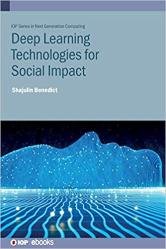Deep Learning Technologies for Social Impact
- Добавил: literator
- Дата: 14-11-2022, 04:46
- Комментариев: 0
 Название: Deep Learning Technologies for Social Impact
Название: Deep Learning Technologies for Social ImpactАвтор: Shajulin Benedict
Издательство: IOP Publishing
Серия: IOP Series in Next Generation Computing
Год: 2022
Страниц: 267
Язык: английский
Формат: pdf (true), epub
Размер: 33.8 MB
Artificial Intelligence (AI) is gaining traction in areas of social responsibility. From climate change to social polarization to epidemics, humankind has been seeking new solutions to these ever-present problems. Deep Learning (DL) techniques have increased in power in recent years, with algorithms already exhibiting tremendous possibilities in domains such as scientific research, agriculture, smart cities, finance, healthcare, conservation, the environment, industry and more. Innovative ideas using appropriate DL frameworks are now actively employed for the development of and delivering a positive impact on smart cities and societies. This book highlights the importance of specific frameworks such as IoT-enabled frameworks or serverless cloud frameworks that are applying DL techniques for solving persistent societal problems. It addresses the challenges of DL implementation, computation time, and the complexity of reasoning and modelling different types of data. In particular, the book explores and emphasises techniques involved in DL such as image classification, image enhancement, word analysis, human–machine emotional interfaces and the applications of these techniques for smart cities and societal problems. To extend the theoretical description, the book is enhanced through case studies, including those implemented using Tensorflow2 and relevant IoT-specific sensor/actuator frameworks. The broad coverage will be essential reading not just to advanced students and academic researchers but also to practitioners and engineers looking to deliver an improved society and global health.
Deep Learning is a subset of the Machine Learning (ML) domain that has created a sharp rise in applications, more specifically, applications for social good. Such applications are used in combination with multiple technologies, such as the Internet of things (IoT), 5G, the blockchain, the cloud, edge computing, and so forth. Deep learning is an incredibly powerful learning mechanism based on the functioning of neural networks which mimic the neurons of the human brain.
Deep Learning is not a competitive technology with respect to Machine Learning and Artificial Intelligence (AI). It is a subset of the other traditional learning systems. It is based on functional layers that utilize raw input data to automatically create abstract features and perform learning tasks such as regression, classification, or ranking. There are several misconceptions about the differences between Deep Learning and AI or Machine Learning.
Generally, intelligence is based on acquiring knowledge from the past and processing it to provide new insights into data. Obviously, human intelligence requires a lot of time to obtain the information required to take decisive actions—i.e. a human being might need several months in infancy to identify a pen or other objects. Artificial intelligence utilizes algorithms and techniques to mimic human-like behavior—i.e. to take correct decisions, such as quickly classifying objects based on previous observations. AI corresponds to digital systems, whereas the human brain resembles an analog system. AI is a basic technique for other techniques such as machine learning and deep learning. Machine learning remains a subset of artificial intelligence. It aims to develop algorithms/programs and insert them into machines to take decisions based on the input data.
Deep Learning evolved as a subset of Machine Learning. It attempts to identify specific patterns or features in data. Utilizing these patterns, deep learning algorithms perform novel inferences and pursue actions. Deep Learning models structure algorithms to create layers of algorithms used to learn data and take decisions in an automated fashion.
The important features of the TensorFlow platform that facilitate the coding of Python-based deep learning tasks are as follows:
- Ease of operation—the TensorFlow platform delivers easy integration with several other platforms, such as Google run time collaboration services or locally connected clusters. Users have to select appropriate compute resources using the platform in order to execute deep learning services in the cloud.
- Ease of representation—in addition, TensorFlow focuses on making it easy to represent data. For instance, Tensors are utilized to represent text, image, or audio data. Tensors are multidimensional arrays that are mainly represented as NumPy arrays, mostly static in nature. Tensors are often represented by strongly typed array representations that are immutable during the execution period. Hence, altering tensors is not possible. However, newer tensors can be created during the execution of Deep Learning tasks.
- Debugging feature—interpreters for TensorFlow have been developed, which use Jupyter notebooks. The Jupyter notebooks allow users to easily develop the code and debug errors that appear due to inefficient coding, etc. An application developer working on deep learning tasks and using more than 20 Python files could find it difficult to trace mistakes or errors using a traditional approach. However, using the TensorFlow platform, they are able to debug them in a short span of time.
- Visualization—the platform provides a visual representation of tensors and variables to programmers. In this way, associated graphs and data can be visualized to some extent using TensorFlow.
Скачать Deep Learning Technologies for Social Impact
[related-news] [/related-news]
Внимание
Уважаемый посетитель, Вы зашли на сайт как незарегистрированный пользователь.
Мы рекомендуем Вам зарегистрироваться либо войти на сайт под своим именем.
Уважаемый посетитель, Вы зашли на сайт как незарегистрированный пользователь.
Мы рекомендуем Вам зарегистрироваться либо войти на сайт под своим именем.
